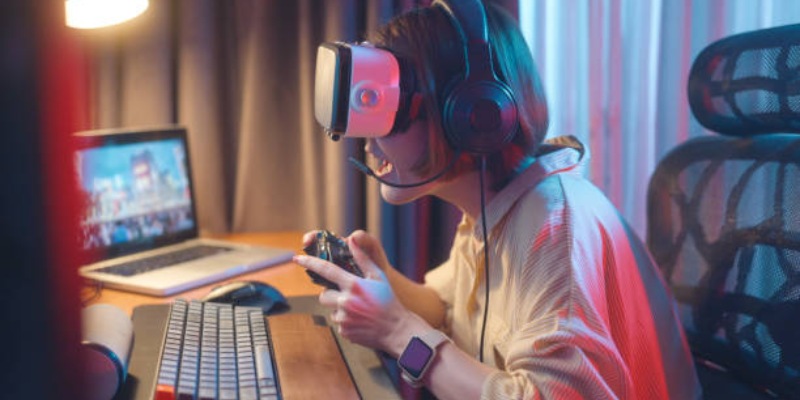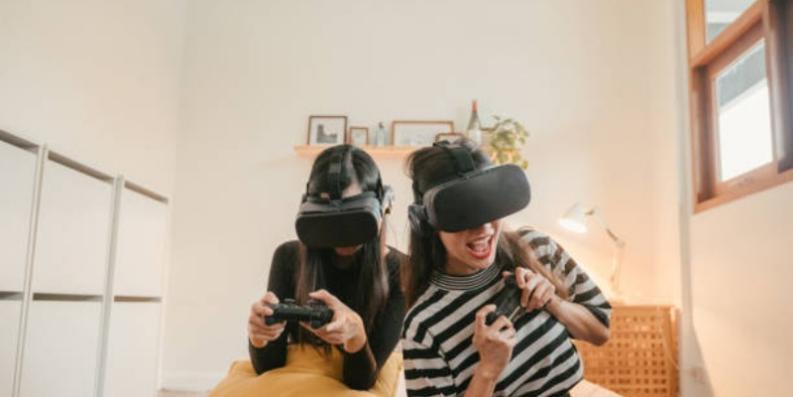How To Choose The Best VR Accessories For Gaming
VR gaming is more immersive than ever, but can you enjoy it fully? The right accessories can make all the difference. From comfort to realism, this quick guide helps you pick the gear that turns good sessions into unforgettable adventures.
Prioritising Comfort And Ergonomics
A great VR experience starts with feeling physically at ease. Headsets and controllers can become heavy or awkward during long sessions, leading to fatigue. Accessories like ergonomic head straps are popular, redistributing weight to reduce pressure on the face and head. Some straps even include padding made from breathable materials to prevent sweat buildup, a common issue during intense gameplay.

Adjustable mounts and stands help position the headset correctly without straining the neck for players who prefer sitting or standing for extended periods. Cooling fans attached to headsets also address overheating, which can cause discomfort in warmer environments. These small upgrades might seem minor, but they make a noticeable difference in how long and comfortably someone can play.
Controllers are another area where comfort matters. Standard VR controllers work well, but adding grips or wrist straps can prevent accidental drops and reduce hand strain. Some accessories mimic real-world tools, like gun stocks for shooting games or golf club handles for sports simulations, blending ergonomics with gameplay immersion.
Exploring Advanced Tools For Realism
For gamers seeking deeper immersion, advanced accessories like haptic feedback suits and gloves add a tactile dimension to virtual worlds. Haptic suits use vibrations and pressure to simulate touch, allowing players to "feel" impacts, explosions, or even subtle textures. While these suits can be pricey, entry-level options like vests or gloves offer a more affordable way to experience haptics without breaking the bank.
Full-body tracking systems take immersion further by translating physical movements into the game. Traditional VR setups often track only the head and hands, but full-body systems capture leg movements, posture, and facial expressions. This level of detail is beneficial for fitness games or multiplayer experiences where precise motion matters.
Motion sensors and trackers attach to limbs or props, syncing with the game to reflect real-time actions. For example, a VR bow and arrow player might attach a sensor to their arm to ensure accurate aiming and drawing motions. These tools require compatible software, so checking system requirements is crucial before purchasing.
Choosing The Right Controllers And Motion Tracking
Controllers remain the primary way to interact with VR environments, making their design and functionality critical. While most headsets come with basic controllers, aftermarket options often provide enhanced features. For instance, some controllers include adaptive triggers that adjust resistance based on in-game actions, like pulling a bowstring or pressing a car accelerator. Others offer modular designs, letting users swap attachments for different genres, such as racing wheels for driving games or sword hilts for action-adventure games.
Hand-tracking cameras are another innovation that eliminates the need for handheld controllers. These devices use infrared sensors to map finger movements, enabling players to interact with objects by simply gesturing. This technology is ideal for games requiring fine motor skills, like puzzle-solving or crafting, but it may not replace traditional controllers for fast-paced action due to latency issues.
Compatibility with the VR headset is key when selecting motion-tracking accessories. Systems like the Meta Quest 3 or HTC Vive have specific tracking requirements, so researching whether a new accessory works seamlessly with existing hardware avoids frustration later.

Enhancing Audio And Visual Clarity
Sound plays a vital role in creating believable virtual worlds. While many headsets include built-in speakers, external headphones or earbuds often deliver superior audio quality. Over-ear headphones with noise-cancelling features help players focus on in-game sounds without distractions, while lightweight in-ear options prioritize portability.
Microphone accessories are equally important for multiplayer games or social VR platforms. A detachable boom mic ensures clear voice communication, while directional mics reduce background noise. Some headsets integrate these features, but standalone mics offer flexibility for users who switch between VR and traditional gaming setups.
Lens upgrades or anti-glare coatings can improve visual clarity. VR headsets sometimes produce a "screen door effect," where visible pixels disrupt immersion. High-quality lenses or software adjustments can minimize this issue. Additionally, cleaning kits designed for VR screens help maintain clear visuals by removing smudges and dust.
Customization And Modular Design
Gaming is a personal experience, and customizable accessories can elevate gameplay. Modular headsets, for example, let users swap components like batteries, cameras, or face cushions. This flexibility extends the device's lifespan and adapts to changing needs, whether adding a longer-lasting battery for marathon sessions or a higher-resolution camera for mixed-reality experiences.
Controllers with interchangeable parts cater to different play styles. A racing enthusiast might prefer a controller with a steering wheel attachment, while a shooter fan could opt for a gun-shaped grip. Some accessories even support programmable buttons, letting players assign complex commands to single presses, streamlining gameplay.
Customization isn’t limited to hardware. Software-compatible accessories, like gesture-recognition plugins or haptic feedback profiles, let users tweak how tools respond to their actions. These options ensure accessories grow with the player, adapting to new games and challenges over time.
Balancing Budget And Long-Term Value
VR accessories vary widely in price, so setting a realistic budget is essential. Entry-level items like replacement straps or basic controllers are affordable ways to improve comfort without significant investment. Mid-range accessories, such as advanced hand-tracking cameras or haptic vests, offer noticeable upgrades but require careful consideration of their impact on gameplay.
High-end purchases, like full-body tracking systems or premium haptic suits, demand a larger financial commitment. Before splurging, research whether the accessory aligns with long-term gaming goals. For example, a fitness-focused player might prioritize motion-tracking equipment, while a casual gamer could enjoy simpler upgrades.
Warranty and durability are also worth evaluating. Accessories exposed to frequent movement or contact, like controllers or tracking sensors, should be built to withstand wear and tear. Brands offering repair services or replacement parts help protect the investment over time.

Staying Ahead With Future-Proof Accessories
Technology evolves rapidly, and VR accessories are no exception. Choosing future-proof products ensures compatibility with upcoming games and hardware updates. Accessories supporting open-source platforms or industry-standard protocols, like USB-C or Bluetooth 5.0, are more likely to remain functional as systems advance.
Wireless accessories reduce clutter and offer greater freedom of movement, making them a wise choice for modern setups. Wireless headsets, controllers, and tracking systems eliminate tangled cords, though they require reliable charging habits to avoid interruptions.
Subscribing to VR news channels or forums can help gamers stay informed about emerging accessories. Early adopters often share insights on compatibility issues or innovative uses for new tools, guiding others toward worthwhile purchases.
Where To Buy And What To Avoid
Purchasing accessories from reputable retailers minimizes the risk of counterfeit or low-quality products. Official stores for headset manufacturers, like Meta or HTC, offer guaranteed compatibility and customer support. Trusted third-party sellers on platforms like Amazon or Best Buy also provide user reviews, helping buyers gauge performance before committing.
Avoiding overly cheap knockoffs is crucial, as they may lack safety certifications or damage existing equipment. Reading return policies and warranty details protects against disappointing purchases. Testing accessories in-store allows hands-on evaluation of comfort and functionality before buying.
Getting Started With Your Vr Upgrade Journey
Choosing the best VR accessories for gaming is a dynamic process that balances personal preferences, budget, and technological advancements. By prioritizing comfort, exploring tools that enhance realism, and investing in versatile, future-proof gear, players can transform their virtual experiences into something extraordinary.
Whether upgrading a headset for clearer visuals or adding haptic feedback for tactile depth, each accessory brings gaming closer to the limitless possibilities of imagination. With thoughtful selection and a bit of research, the journey into VR becomes not just immersive, but uniquely tailored to every adventurer’s dreams.